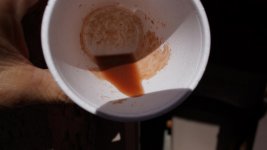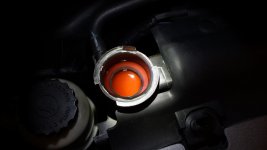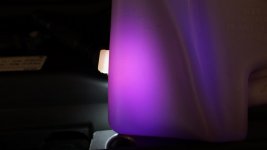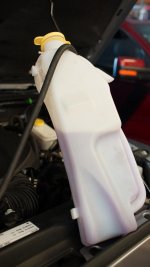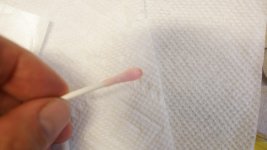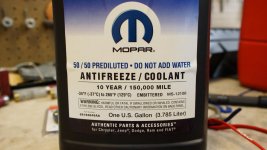You are using an out of date browser. It may not display this or other websites correctly.
You should upgrade or use an alternative browser.
You should upgrade or use an alternative browser.
ATTENTION: Know Your Jeep JK Wrangler Coolants and Save Your Engine!
- Thread starter NFRs2000NYC
- Start date
wwood
Member
Some additional info
I have a 2013 JKUR purchased July 2013. Spotted this thread months ago when the Jeep had about 2,500 miles. Checked but did not see any sludge in the coolant overflow bottle. Checked the bottle recently at about 7,500 miles and saw about an inch or so of brown sludge at the bottom. Stuck a long stick in the bottle but no sludge came out on the stick, so it must be pretty watery, not thick like I saw in other posts.
Made a service appointment with Airpark Dodge in Scottsdale. They said the sludge was "barleak" (factory applied stop leak) and agreed to flush cooling system under warranty. I agreed. Had to wait about 2 hours but was happy to get that gunk out of my Jeep.
Labor: 8748 Flush out cooling system and overflow bottle 0.80 hrs - Completed
Parts: 1 P/N 68163848AA Antifreez-Coolant
As to the sludge being factory applied stop leak...... barleak??
Why would a new vehicle need stop leak applied at the factory? They can't make engines that don't leak coolant?
Never heard of barleak so I looked it up. To my surprise, I found an actual company with a long successful history called Bar's Leaks that makes coolant stop leak and other products that really are used on OEM assembly lines by major US auto makers:
http://barsproducts.com/company/history
So it appears the dealer was correct when they told me the sludge was factory applied stop leak and that, having flushed it out, I should not have any problems or see any further build up in the overflow bottle.
Anyway, my dealer let me examine the sludge before they did the system flush. The brownish gunk is pretty watery, too thin to clog up the heater core or anything else. I smelled it and rubbed it between my fingers. The stuff is soft, smooth, no grit, no sand. Smells funny, not bad, nothing it reminds me of. I have had some of it sitting in a cup for a week or so and it is still soft, not hardening up at all. Definitely not a clogging risk so I feel the flush would have removed any of it still inside the cooling system. Don't know exactly what a cooling system flush consists of but I feel confident this stuff is not a problem.
Couple of other things....
1) 2013 Mopar coolant is sold under 2 part numbers 68163848AA for concentrate (not diluted with water) and 68163849AA for pre-diluted 50/50 with water.
2) As stated in the original post, the coolant can be orange or purple depending on the light. When you open the radiator cap and shine a flashlight in the hole the stuff looks orange. But if you dip a Q-tip or paper towel in the liquid and hold it up it looks purple. If you look at the overflow bottle it looks purple but if you shine a flashlight through the bottle it looks orange. Weird.
Bottom line: if you see sludge in your overflow bottle, stick a long stick in there and stir the sludge a little while shining a flashlight through the bottle. If nothing comes out on the stick and you can see through the bottom of the bottle, the sludge is watery and probably won't cause any problem. Not a bad idea to get dealer to flush system if under warranty or do it yourself if not. If the sludge is thick like pudding as shown in earlier posts, then you have a totally different problem and I would definitely want the dealer to correct it which might mean replacing the radiator and heater core.
Incidentally if you want to remove the coolant overflow bottle, mine came off with no tools, simply pulled it straight up, it hooks into 2 slots.
Here is a pic of the sludge, coolant overflow bottle, 2013 new coolant jug, and the odd color variations:
I have a 2013 JKUR purchased July 2013. Spotted this thread months ago when the Jeep had about 2,500 miles. Checked but did not see any sludge in the coolant overflow bottle. Checked the bottle recently at about 7,500 miles and saw about an inch or so of brown sludge at the bottom. Stuck a long stick in the bottle but no sludge came out on the stick, so it must be pretty watery, not thick like I saw in other posts.
Made a service appointment with Airpark Dodge in Scottsdale. They said the sludge was "barleak" (factory applied stop leak) and agreed to flush cooling system under warranty. I agreed. Had to wait about 2 hours but was happy to get that gunk out of my Jeep.
Labor: 8748 Flush out cooling system and overflow bottle 0.80 hrs - Completed
Parts: 1 P/N 68163848AA Antifreez-Coolant
As to the sludge being factory applied stop leak...... barleak??
Why would a new vehicle need stop leak applied at the factory? They can't make engines that don't leak coolant?
Never heard of barleak so I looked it up. To my surprise, I found an actual company with a long successful history called Bar's Leaks that makes coolant stop leak and other products that really are used on OEM assembly lines by major US auto makers:
http://barsproducts.com/company/history
So it appears the dealer was correct when they told me the sludge was factory applied stop leak and that, having flushed it out, I should not have any problems or see any further build up in the overflow bottle.
Anyway, my dealer let me examine the sludge before they did the system flush. The brownish gunk is pretty watery, too thin to clog up the heater core or anything else. I smelled it and rubbed it between my fingers. The stuff is soft, smooth, no grit, no sand. Smells funny, not bad, nothing it reminds me of. I have had some of it sitting in a cup for a week or so and it is still soft, not hardening up at all. Definitely not a clogging risk so I feel the flush would have removed any of it still inside the cooling system. Don't know exactly what a cooling system flush consists of but I feel confident this stuff is not a problem.
Couple of other things....
1) 2013 Mopar coolant is sold under 2 part numbers 68163848AA for concentrate (not diluted with water) and 68163849AA for pre-diluted 50/50 with water.
2) As stated in the original post, the coolant can be orange or purple depending on the light. When you open the radiator cap and shine a flashlight in the hole the stuff looks orange. But if you dip a Q-tip or paper towel in the liquid and hold it up it looks purple. If you look at the overflow bottle it looks purple but if you shine a flashlight through the bottle it looks orange. Weird.
Bottom line: if you see sludge in your overflow bottle, stick a long stick in there and stir the sludge a little while shining a flashlight through the bottle. If nothing comes out on the stick and you can see through the bottom of the bottle, the sludge is watery and probably won't cause any problem. Not a bad idea to get dealer to flush system if under warranty or do it yourself if not. If the sludge is thick like pudding as shown in earlier posts, then you have a totally different problem and I would definitely want the dealer to correct it which might mean replacing the radiator and heater core.
Incidentally if you want to remove the coolant overflow bottle, mine came off with no tools, simply pulled it straight up, it hooks into 2 slots.
Here is a pic of the sludge, coolant overflow bottle, 2013 new coolant jug, and the odd color variations:
Attachments
WranglerJack
New member
wwood
Member
I found this interesting .
http://www.youtube.com/watch?v=t7PykrgzWPQ
Yes very interesting. Here is the part I did not like about Evans coolant according to the following quote from their own tech info on their website: http://www.evanscooling.com/
"Engines filled with Evans usually run 3 - 10ºC hotter than those using water-based coolants, but the overall heat transfer and engine efficiency is improved through the elimination of steam-vapour pockets. The lube-oil temperature also runs 3 – 10ºC hotter with Evans but >500,000 successful conversions confirm this has no detrimental effect."
3 deg C is 37.4 deg F
10 deg C is 50 deg F
I don't like the idea of my coolant or lube oil running anywhere from 37-50 degrees F hotter than normal. I also don't like the fact that Evans uses Centigrade on their website instead of Fahrenheit which makes the temp differences look small. Some people might not notice this little trick.
Plus I immediately wonder why the major US auto makers don't use Evans coolant if it is better than traditional antifreeze. Maybe its because of the higher running temps.
wwood
Member
They don't use it because of cost.
Could be but according to the Jay Leno video above, Evans is only $39/gal.
I think I paid that much or more for the gal of factory antifreeze I bought for my Jeep and my Ford truck.
Plus according to Evans their coolant never needs to be flushed out and replaced or even topped off.
Jaydoc1
New member
Could be but according to the Jay Leno video above, Evans is only $39/gal.
I think I paid that much or more for the gal of factory antifreeze I bought for my Jeep and my Ford truck.
Plus according to Evans their coolant never needs to be flushed out and replaced or even topped off.
That's about what I paid for the OEM coolant from the dealership as well. :yup:
Manufactures by in bulk. That company may also be too small to support everything else that goes with working with a man. Like auto debit if your company can't deliver, product is late and the fines involved because of rework costs etc. There is a lot more behind the scenes that is involved.
Zstairlessone
New member
Yes very interesting. Here is the part I did not like about Evans coolant according to the following quote from their own tech info on their website: http://www.evanscooling.com/
"Engines filled with Evans usually run 3 - 10ºC hotter than those using water-based coolants, but the overall heat transfer and engine efficiency is improved through the elimination of steam-vapour pockets. The lube-oil temperature also runs 3 10ºC hotter with Evans but >500,000 successful conversions confirm this has no detrimental effect."
3 deg C is 37.4 deg F
10 deg C is 50 deg F
I don't like the idea of my coolant or lube oil running anywhere from 37-50 degrees F hotter than normal. I also don't like the fact that Evans uses Centigrade on their website instead of Fahrenheit which makes the temp differences look small. Some people might not notice this little trick.
Plus I immediately wonder why the major US auto makers don't use Evans coolant if it is better than traditional antifreeze. Maybe its because of the higher running temps.
Ok, for actual temperature 3° C is equal to 37° F, but 3° C hotter than a given temperature is only 5.4° F hotter, not 37° F hotter and 10° C hotter is 18° F hotter.
Thing is the oil temp getting hotter is ridiculous (but true), if you transfer more heat out of the engine then you need to transfer more out of the radiator or the water heats up, raising efficiency, but causing block and component temps to rise which puts a load on the oil to cool more. Oil temp goes up and oil life goes down (by half I think for every 10 ° C rise in operating oil temp.
Plus I think the design of these engines will have the engine temp rise with a rise in coolant temp so the efficiency may not go up (based on a differential temp) and if both go up.....
Engine efficiency goes up because the heat sink temp is higher (more energy into power, less into heat loss) but there are things to consider, like the effect on oil quality and life, the trade off is getting efficiency within the design of the components of the engine and all it's interrelated systems.
Edit: I may be wrong (and have been many times before) but there is probably a ME or two here that can really answer this.
Last edited:
wwood
Member
Ok, for actual temperature 3° C is equal to 37° F, but 3° C hotter than a given temperature is only 5.4° F hotter, not 37° F hotter and 10° C hotter is 18° F hotter.
Z, you are correct, I said the temp differences wrong.
A 1 deg C difference (rise or fall) in temp is equal to 1.8 deg F. So, as you said, a temp increase of 3 deg C is 5.4 deg F and a 10 deg C increase is 18 deg F.
My point is the same - Evans used C to make the temp increase look smaller. They should have used F since we are in the US or given both numbers.
Having our engine and oil temps run 5 to 18 deg F higher than normal cannot be good. They say it does no harm but they are trying to sell their product......
The coolant now sold by Mopar for 2013+ Jeeps is rated for 10 years, 150k miles. Pretty much covers the life of the vehicle. Don't see a reason to switch to Evans.
cozdude
Guy with a Red 2-Door
Thanks to the OP, great post! Haven't read the 80+ replies but how do I make sure what coolant I have in my 2013? Thanks in advance
Envoyé de mon iPhone à l'aide de Tapatalk
according to this you should have OAT (purple). you could look at your over flow container and check to make sure the right one is in there if you had your coolant flushed since you first picked up your jeep. if you got it fresh off the lot you should have the right one in there from the factory.
cozdude
Guy with a Red 2-Door
I have a brand new 2014 and its orange.
If you go back to the original post by the op he states that the purple looks orange at different angles and provides pics. I would bet that this is what your noticing
NFRs2000NYC
Caught the Bug
Just stuck a stick down into the bottom of the coolant reservoir, I definitely have about a "1-1/2 of light brown sludge, like a previous post stated,
Any thoughts???
Supposedly the sludge is perfectly normal. Chrysler apparently adds stopleak to radiators to make sure the system is sealed. If you pull some sludge out, you will see it's almost 100% liquid. You can demand your dealer do a flush, I don't like my dealer doing anything not necessary. If you are under warranty, leave it alone. If you want, take some pics so you have some backup proof.

